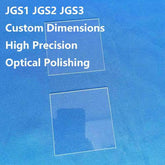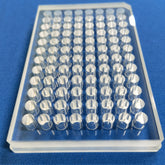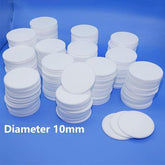Application of two-sided sapphire polishing in industrial production
Sapphire glass is a high-performance optical material that has demonstrated considerable application potential in a variety of fields, including scientific research, industrial production and consumer electronics, since its inception. This is attributable to its distinctive physical and chemical properties. It is particularly noteworthy that, following the precision double-sided polishing treatment, these glasses exhibit exceptional optical properties and other key performance indicators, thus becoming a core component in numerous fields. This article will discuss the properties of sapphire glass after two-sided polishing, and its wide application in research and industrial production.
1. Significant improvement in optical performance
Sapphire demonstrates excellent light transmission properties, with the capacity to transmit light across a broad spectrum ranging from the ultraviolet to the visible wavelength, and extending to the near-infrared wavelength. This attribute renders sapphire glass particularly well-suited for applications that demand both high light transmission and an extensive spectral response. The double-sided polishing process further improves the surface finish and flatness of the glass, reduces the scattering and reflection of light on the glass surface, and thus improves the transmittance of light. It has been demonstrated that, within the domain of optical instrumentation, such as high-precision telescopes, microscopes and spectrometers, the utilization of sapphire glass facilitates the acquisition of clearer and distortion-free images. This enhancement in image quality has been shown to result in an improvement in the observation and measurement accuracy of the equipment.

Furthermore, the high refractive index (approximately 1.76-1.78) and appropriate dispersion properties of sapphire make it an ideal material for the manufacture of high-quality lenses and prisms. The optical properties of sapphire are inherently conducive to the fabrication of optical systems that exhibit superior color reproduction and contrast, thereby catering to the requirements of scientific research and industrial domains for high-precision optical measurement.
2. Precision machining and customization requirements
Two-sided polishing is one of the key steps to improve the properties of sapphire glass, which involves complex mechanical and chemical processes and requires high machining precision and quality control. With precise grinding, polishing and cleaning steps, it is possible to ensure that the surface of the glass reaches the nanometer level of flatness, while removing all processing marks, leaving the glass surface as smooth as a mirror.

Moreover, the advent of contemporary processing technologies has engendered the capacity to actualize a plethora of customization designs, encompassing an array of shapes, sizes, thicknesses, and distinctive optical coating treatments, thus ensuring the satisfaction of specific application requirements. For example, in laser radar systems, customized sapphire glass can optimize the divergence angle and focusing performance of the beam, improving the detection range and accuracy; In the medical field, sapphire glass after special coating treatment can possess anti-reflection, anti-ultraviolet and other characteristics to protect the eyes from harmful light.
3. Extensive application in research and industrial production
In the field of scientific research, the excellent properties of sapphire glass make it a widely used material in high energy laser systems, quantum optical experiments, astronomical observations and other fields. Its high light transmittance, high thermal stability and chemical inertness ensure the stability and reliability of scientific research equipment under extreme conditions, and promote the development of scientific research.

Sapphire glass is a material of great industrial importance. In the field of optical processing, it is a key material in the manufacture of high-precision optical components. In the realm of semiconductor manufacturing, sapphire substrate is utilized in the epitaxial growth of high-quality LED sheets, thereby enhancing the luminous efficiency and longevity of LEDs. In the domain of aerospace engineering, the notable properties of lightness, strength, and resistance to high temperatures of sapphire make it a suitable candidate for the fabrication of critical components such as spacecraft portholes, navigation system windows, and other key aerospace elements. In the field of military technology, the material's notable properties of anti-impact and anti-radiation make it a highly sought-after component in night vision devices and other military equipment.
Sapphire glass, following a double-sided polishing treatment, exhibits optical properties as well as various other physical and chemical properties, thus rendering it applicable in a variety of contexts. These include scientific research, industrial production, and the daily life of electronic products. These applications underscore the distinctive attributes of this material and its considerable potential.






